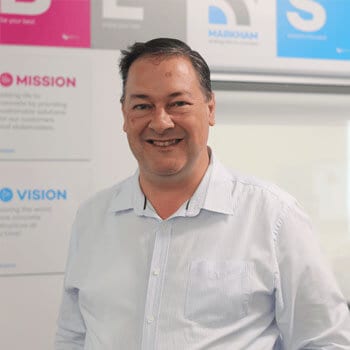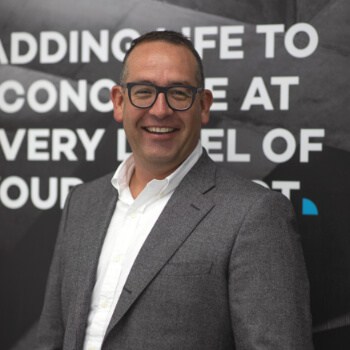In this free-ranging interview, Mark Smith, CEO of MARKHAM, travels through the many ways that MARKHAM is saving the world and adding life! He draws on the original founders’ vision and talks about how that’s working out in today’s world.
MARKHAM in the Concrete Industry

Invisible Strength
MARKHAM in the Concrete Industry
/
RSS Feed
MARKHAM in the Concrete Industry
CONQOR B50 admixture – markhamglobal.com/markham-products/additives-for-waterproofing/conqor-b50-sustainable-concrete-waterproofing-admixture
CONQOR B25 admixture – markhamglobal.com/markham-products/conqor-range/conqor-b25-admixture
CarbonCure – carboncure.com
View the Transcript
BRENDAN: Good day, everybody. Welcome to the latest segment of MARKHAM’s Invisible Strength Podcast. I’m Brendan Stead from the marketing department, and with me today in the Sydney office is our CEO, Mark Smith. How are you going, Mark, and how are you handling the weather?
MARK: Thank you very much. Yes, it’s great to be here for the first time in three years. It was late 2019 that I was last in this office, so it’s great to see the team again.
BRENDAN: Absolutely excellent. So today, we’re going to have a chat about a very important topic, which is sustainability in the concrete industry, and what MARKHAM is doing in that space, and who better to help us with that than the CEO? Mark, thinking about the background and history of the last 25 years, the products traditionally we’ve worked with have always had a meaning to being environmentally friendly, haven’t they?
MARK: Well, I think it goes right back to the initial version that my father Graham Smith had when he started the business, founded the business in 1996. Not many people were actually talking about sustainable solutions, and actually, his mission statement was about providing sustainable solutions for protecting concrete for the future generations, which is our take today on providing sustainable solutions. So the products that we’re promoting, the colloidal nanosilicas, are all in the waterborne range.
So not only are we just no-VOC, like a lot of acrylics and things that are on the market that might be nil or low-VOC, they’re still not completely environmentally friendly to the actual environment. So if our nano colloidal silica has got, for instance, spilt on the ground, or even went into a waterway, they actually can go and be treated on to potable water tanks. So from that point of view, we are a whole step ahead of not just being nil-VOC, but we’re actually about providing a sustainable, environmentally friendly solution. That’s probably where it’s led to us getting the Environmental Choice certification or licence for across New Zealand and Australia, for those products that we’re offering for concrete curing, concrete, waterproofing, and concrete hardening. So the sustainability part has been actually, I would say, a founding chapter for MARKHAM.
BRENDAN: That’s good. It’s not just the tagline, it’s been part of our approach from the early years. Now you mentioned the Environmental Choice New Zealand Enviro label.
MARK: Well, that was actually quite a fun process to go through, obviously watching the certification process go through all the chain of supply chain. That’s why I’m quite passionate. You see people putting out there that they’re environmentally friendly. But to be actually certified to be environmentally friendly goes right through from the raw materials, all the things that you’re doing in your process. For instance, when they went through our factory, they were looking at, what do we recycle; what do we recycle in our office environment and our factory environment? Do we collect any wash water so that it doesn’t contaminate, like if we’re recycling pails? What are we doing for sustainability in the big picture? So we did things like putting more skylights in our warehouse so we’re using actually less power using the natural lighting. We put in some more things around actually our recycling of pails, which we try to do as much as possible.
I suppose it’s all a greater good. But one of the things I would say is that when you ask for an Environmental Choice product or a Green Star product, what some of the consumers or end users or builders architects need to actually do is check that the actual certification is up-to-date on the current supply chain. Because there’s a lot of times that the supply chain actually changes over the years, and you might have had a product that was certified back maybe five or six years ago. But because of the dynamics of COVID and all the different things of supply chain, it can be a completely different supply chain.
So when they did that certification process, they got right back to where all of our raw ingredients come from. I suppose that’s what I can be proud of, is we know that our AQURON products and our concrete products being the nano colloidal silicas, which are waterborne and no-VOC, have gone right through that thing. So we can be beyond reproach for actually providing a sustainable solution. So I’m really excited to say, we can provide sustainable curing options, we can provide sustainable waterproofing options, and we can save the world, one concrete structure at a time.
BRENDAN: Well, there you go, I was going to ask you about that one. Because that’s the main vision, isn’t it: Saving the world, one concrete structure at a time? Can you give us your thoughts on the big picture, how does that work, and adding life to concrete?
MARK: Well, I suppose the “Saving the world, one concrete structure at a time” sounds a reasonably big statement. But if you break that down, what are we actually saving? So we’re saving time and hassle for new construction, and we’re also eliminating risk. If we’re protecting a wharf and extending the life of a wharf structure, if you think about if they don’t go and protect a wharf and extend the durability, how much disruption that makes to all vectors of life? It could be the freight sector, it can be the shipping sector, that’s just one way.
Thereby, us extending the life of, say, a wharf means that we are saving the world, one concrete structure time. Because we’re saving them money, and we’re saving them time. On a new construction, we actually can be saving them risk. So when we’re talking about saving, it’s not necessarily going out and being the person that fixes all things in the world. But we are protecting each structure, and we’re playing our little part to sustainably save the world, in extending the life of concrete structures. That’s where, I suppose, our tagline of “Adding life to concrete,” which is what MARKHAM is all about, comes from.
So our vision is Saving the world, one concrete structure at a time. The tagline is: Adding life to concrete. I think everything we do is adding some form of life, whether it’s adding a gloss to the surface that actually gives a sheen, so that it’s actually a nicer, more durable surface to work from. Or it’s just extending the life of the concrete. But one of the things I really love about the nano colloidal silicas is how it leaves the concrete looking natural. So we’re not darkening the concrete, we’re not changing the concrete. So we’re leaving concrete in its raw state, but we’re protecting it by internally forming a hydrogel inside the concrete. So we’re in the tens of thousands of projects now across New Zealand and Australia, since we started 25 years ago, and definitely past 25 million square metres. I don’t know any project that we have done, which our QA records go right back into 1996, that we’ve ever redone a project. So that’s probably proof in us being a sustainable solution, actually never having to go back and be redone.
BRENDAN: That’s excellent. You mentioned the word durable. Can you say something about what makes the concrete itself last longer, so that we’re saving needing new concrete?
MARK: Well, one of the things is that everyone thinks concrete is waterproof in itself. But it’s not. Moisture can move through concrete. It’s internationally accepted that if you stop moisture moving through concrete, you stop all forms of corrosion of the reinforcing steel, and actually all forms of corrosion within the actual concrete itself. So if corrosives like salts or sulphates, or even just chemicals, get into the pore of the concrete, they start breaking down.
It’s almost like, I like to use an analogy that a concrete structure is not too different to the human body. When I talk about the human body, if you think about the structural steel being like the bones of concrete, and think of the sand and cement and aggregates being like the flesh, then you’ve got all the porosities which were made originally by the escaping bleed water like the veins. So moisture is like the blood. If you let moisture move around the concrete through the porosities, which are like the veins, it can take any corrosives with it. I say it’s a little bit similar to if you have skin cancer on the surface and you leave that untreated, it gets worse and worse and worse, until finally, it gets to being a bone cancer. That’s a real simple analogy that most people can understand.
So we are effectively embalming the concrete by stopping the movement of moisture, in a sustainable way, environmentally friendly. We are not adding anything to concrete that is not already in there. So the hydrogel, the nano colloidal silicas actually achieved after they’ve reacted in the concrete, is actually more of what’s already in concrete. That’s why we say, anything that is compatible with concrete is compatible with our products. You say, well, that’s a bold statement, how can you tell? Because if they’re not compatible with our product, which is making just more of what’s already in concrete, they physically are not compatible with concrete. So we can be absolutely beyond reproach that we are compatible with any type of product that is compatible to be put on to normal, untreated concrete. So there’s lots of sustainable solutions that we can be providing, along the things of moisture protection underneath floor coverings, protection underneath floor coverings in aged care where there’s bio-fluids and spills.
Now, when it comes along to the saving, a lot of alternatives that are passing the curing standards or passing the sealing standards, what ends up happening is that a lot of them being solvent, some of them can be up to 50–70% xylene. Now, we’re talking that if you just took a 40,000 square metre warehouse unit, which is going up pretty regularly in Australasia at the moment, if they went and put on a standard curing compound that actually passes all the 3799 standards, that they would have to put that on at 5 square metres per litre. By doing that, they would then have to be putting on 8,000 litres of product. Now, 8,000 litres, even at the minimum – some of them being as high as 70% xylene, down to 50% xylene – that means there’s 4,000 litres of xylene evaporating into the atmosphere, which has to be not a sustainable solution.
Versus, our products can go on providing an internal moisture protection. So we’re quite different to some of the other products that are out there, as in we’re effectively waterproofing or embalming inside the concrete, so we’re helping in a curing sense of concrete. Because you’re keeping the moisture inside the concrete where you need, versus being a film that’s trying to trap it underneath. So for, say, a curing slab of 40,000 square metres, we can straight off the bottom line, take 4,000 litres of xylene off if you’re using a chlorinated rubber. If you’re using just a standard acrylic, you’re still going to put 8,000 litres of acrylic that has a large proportion of resins in it that are not 100% environmentally friendly; they might be VOC-free, but they’re not 100% environmentally friendly.
So I think we’re joining with the sustainability movement to actually provide those services. I love the whole idea of the CarbonCure products that are out there. One of the things we can help doing is, why would you go and put a sustainable concrete in to then add to the concrete, a petrochem or an acrylic type additive that’s making workability improved. Why would you do that? That’s where I think MARKHAM can step in and provide a 100% sustainable workability admixture.
So everything we’re doing comes back down to the fact that can we do it in a more sustainable manner, and not using your traditional resins and solvents and all those things? But where I think the world gets a little bit confused is, are we talking about no-VOC? Because no-VOC doesn’t mean environmentally friendly or sustainable. But MARKHAM is all about providing no-VOC, and sustainable and environmentally friendly, if that makes sense.
BRENDAN: That’s helpful. Just picking up on one thing you said, if I might digress, if you could tell us a little bit about the sourcing of that sustainable workability product in the CONQOR sustainable waterproofing product?
MARK: Well, I think probably we need to first start off here. Even though our CONQOR products, which are admixtures, are still colloidal nanosilicas, they’re quite different to the AQURON range of products. The AQURON range of products is still a colloidal nanosilica, but it has a unique catalyst to allow it to penetrate into existing concrete; spray-on to concrete. So those products in the supply chain are already proven to be environmentally friendly. But going another step further on that, if you would just say the environmentally friendly of the environmentally friendly, you move up to what I say is our CONQOR range. The CONQOR B25 being the sustainable workability admixture, and the CONQOR B50 which is the sustainable waterproofing admixture. They’re actually nanosilicas rather than being manmade; a nanosilica is normally made from providing a sodium silicate and putting it through a number of heat processes till it becomes a colloidal silica.
So what does colloidal silica actually mean? It means particles in suspension. So fog is actually colloidal water, and we all know that fog can get a lot more places than a puddle can get. In the same way, colloidal silica can get a lot more places than just something like a sodium silicate, which immediately, as it hits the concrete, starts to trying to react. So coming down where do we go is that the standard colloidal silica which is manmade, even though they’re environmentally friendly, they take lots of energy and lots of effort to get them, so that the particles in the nanoparticle size are still in suspension. But with our CONQOR admixtures, the B25 workability and the B50 waterproofing, their colloidal silica source actually comes from a by-product of the geothermal industry. So rather than actually getting a nanosilica particle and boiling it down or applying energy to make it nano, the actual geothermal industry starts off with a nano size, which is many times smaller than what you would normally get from a manmade. But to get it equivalent, I’ve actually got to culture it up. So they go through a number of processes to make the nano sizes bigger than they come out of the ground.
So every single part of our CONQOR [sustainable admixture] products actually comes from the sustainable geothermal industry. Therefore, we’re putting into concrete that which is coming out of Mother Nature. That’s why, at MARKHAM, I think we’ve been leaders for a long time on the sustainable movement when everyone else has been pushing acrylics and petrochem type, and only now are people starting to dawn that concrete is such a major contributor to CO2 emissions, and all those things. So I think Graham was actually very forward-thinking in what he produced as a vision for MARKHAM. All I can be thankful for now is the team that we started off with, being a small family-owned business, to now being across New Zealand, Australia, being distributed up in the Asia and UK, with close to 70 employees now across foot that’s full time with ourselves, let alone all the agents and distributors and people actually promoting.
So we’ve got, I believe, the biggest breakthrough for sustainable admixtures and concrete that will support the CO2 treatments like CarbonCure. We can’t do the same thing as CarbonCure, but what we can do is provide them with products that can be used in conjunction with them, like waterproofing, and like making a more workable concrete. Because sometimes, those carbon mitigating mixes can be a little bit dry for the concrete layer to use until he gets used to it, so the first thing he wants to do is add your standard old workability.
Those technologies have actually been around since the ‘40s. But it’s only since the very recent years actually, geothermal harvested nanosilicas were only actually commercially available in the last three years. Prior to that, you could only get colloidal nanosilica from manmade process. Obviously, concrete is not the only thing that that product goes into; it goes into things like contact lenses, it goes into heart medication, it goes into defoaming of oil wells, it goes into the pulp and paper industry for defoaming the mixers.
So it’s really interesting that of the amount of the colloidal silica that’s actually made in the world, actually only a small proportion of it goes to concrete, until now. That’s where MARKHAM is, I think, leading the charge in providing a sustainable solution for concrete. I’m really proud to be technically the second generation pushing that through. My dad started it, I’ll carry it on, and I hope to pass it on to my son that will take that on. By the time it’s got to that point, I hope to see that you won’t have the option of having or being able to use these nasty products that do have xylene in them and do have resins in them, because we don’t need to use them.
BRENDAN: It was a good touch, Mark. That’s very good. That’s very broad-ranging, what you’ve given us. So thank you very much for joining us today and giving us your insights on that. Really appreciate it.
MARK: Yeah, thanks, Brendan. As you can see, I’m rather passionate about it, and I’m prepared to talk it through with anyone that wants to discuss how we can help them provide a more sustainable solution for building warehouses, building retail complexes, building apartment buildings, building basements. We have so much expertise within our team that can help do that, and let’s do it in the most sustainable way we can.
BRENDAN: Very good. If anybody wants to reach out and contact us, get in touch with Mark via the contact us page on the website: www.MarkhamGlobal.com. Thank you very much, and we look forward to you listening next time we’re on board!
Want to Contribute?
Feedback on our podcasts? Suggestions for future topics? Looking for more information on topics we’ve discussed? Send us a message – we’ll be in touch within a day or two.
More about MARKHAM
MARKHAM are dedicated to providing innovations for concrete and construction. Focusing on concrete waterproofing solutions, penetrating concrete sealers and durability treatments for concrete.
Podcast Categories
Latest Episodes

Doug & Laike Share Their Week – Western Australia, Christchurch, and a Focus on Low Carbon Concrete
Laike and Doug wrap up their week again with a 10-minute chat. They’ve each been

Doug & Henry Share Their Week – R&D, Melbourne Traffic, Basement Waterproofing, And ‘CONQOR Your Health’
It’s Henry’s turn to join Doug in the podcast studio – in person this time!

Doug & Laike Share Their Week – Seychelles, Readymix Plants, And A Bike Ride
Once again Doug and Laike sit down for a 10 minute recap from the week.
invisible strength podcast
The whole MARKHAM team is pleased to present you with our podcast series, INVISIBLE STRENGTH. In this series of interviews, we’ll walk through the science and challenges of concrete durability, what goes wrong in the field – and the advanced methods available to restore and enhance service life to concrete construction.
INVISIBLE STRENGTH reflects a number of factors in concrete construction and durability. When things go wrong, the evidence can become very visible indeed. However, when all is going well, there’s nothing particular to be seen!
MARKHAM’s concrete treatments, too, are invisible once completed – and the result is the long internal, invisible durability of the concrete.
So join us as we explore the unseen world inside concrete – why it matters, and how it can be protected!

